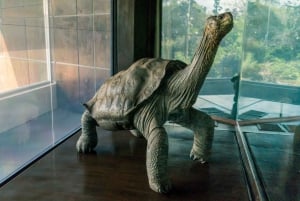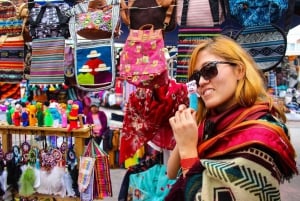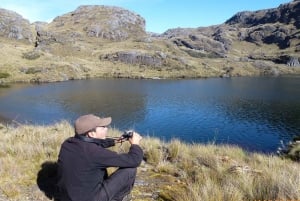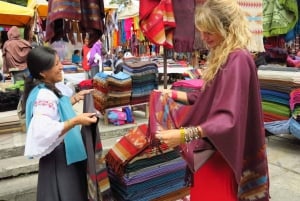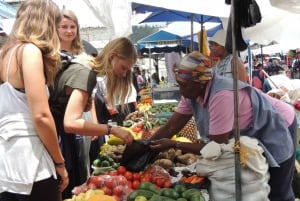History and Culture
Pre-Incan Civilizations
Several very advanced cultures dating back to approximately 9,000 BC are known to have populated what is Ecuador today. Among those, stand out on the coast the Valdivia, the most ancient known culture of the Americas, the Machalilla, Huancavilca, and Manta, and the Caranquis, Quitus and Cañaris, among others, in the highlands. There is very little reference of the inhabitants of the Amazon region, but there are traces of very ancient tribes in that area; today’s Shuars are direct descendants of one of those tribes. Vestiges of these ancient civilizations can be found today throughout the country in the form of utensils and ornaments in museums as well as archeological remains.
The Inca Conquest and Domination
Centuries of tribe expansion, wars, and alliances preceded and probably contributed to the conquest by the Incas from the south (what is Peru nowadays), which started around the year 1450. In spite of the ferocious resistance of the various local tribes and cultures, the Incas consolidated their domination of the region in the early 1500s, with the Inca Huayna Capac as leader. Once Huayna Capac died, two of his sons, Huascar and Atahualpa, each building up military and political power around them, tried to seize command of the Inca Empire (the Tahuantinsuyo) engaging in several war conflicts that ended with Huascar’s defeat and execution in 1532. This struggle weakened and divided the empire, easing the way for the Spanish invaders under the command of Francisco Pizarro who arrived from the north and ended Atahualpa’s rule capturing and executing him in 1533. And so, the Inca presence and domination in today’s Ecuador lasted less than 100 years but their impact was strong and they left an important legacy. Ruins of the Empire can be seen in places like Ingapirca in the province of Azuay, and the city of Cuenca was founded on the ruins of the Inca city of Tomebamba.
The Spanish Conquest and Domination
The Spanish conquistador Francisco Pizarro conquered through the terror caused by his armies’ horses (unknown before that), armors, and firearms. This was the beginning of Spanish Domination in Ecuador and the rest of the region, which continued expanding until the beginning of the 19th century. The King of Spain imposed a colonial system under his rule, where natives were slaved and mistreated. Cities were founded and new generations of "criollos" (Spanish descendants born in America) were born. Influenced by the Catholic Church, religious art flourished leaving evidence until today in churches and convents throughout the country. The "mestizo" population, which is the majority nowadays, is the result of the intermixing of the Spaniards with native women. Criollos had great economic power and social consideration, but Spanish born were favored for political and clerical positions. This and the discontent with unfair commercial and tax laws originated tensions and dissatisfaction among the population of the colonies.
Rebellion and Independence
The first rebellious movements started in 1809 with the uprising of the criollos against the authorities in Quito and against the new King of Spain Joseph Bonaparte. On the 10th August the rebels formed a temporary government but it was crushed by the royal troops. Although this uprising did not seek independence, the 10th August 1809 is known as the "First Cry of Independence". The independence movements really began on the 9th October 1820 in Guayaquil where the authorities loyal to the King were expelled and the Free Province of Guayaquil was declared. Then, Simon Bolivar, who was already engaged in his Campaign for the Liberation of America to form Gran Colombia (translated Great Colombia), a big American country, commissioned Antonio José de Sucre to liberate Quito. The independence was finally attained on the 24th May 1822 with the Pichincha Battle, which was fought on the slopes of the Pichincha volcano and ensured the Independence from Spain of the whole Ecuadorian territory. This date is celebrated as Independence Day. Ecuador was then annexed by Bolivar to Gran Colombia which he presided.
The Republican Period
In May 1830, as Bolivar’s great unification project failed, a group of Quito notables met to dissolve the union with Gran Colombia and, a few months later, a constituent assembly wrote a constitution for the State of Ecuador, so named for its closeness to the equator, and placed Venezuelan General Juan José Flores in charge of political and military affairs. Flores remained the main political figure during the first 15 years of independence until, in 1845, with the whole nation discontent with his bad management, an insurrection in Guayaquil forced him from the country. Since then until 1860, when the conservative Gabriel García Moreno became president, Ecuador went through a very turbulent and chaotic period, with authorities fighting among themselves, Flores attempting from exile to overthrow the government, local caudillos declaring autonomy of regions, and so on. The worst episode was that of Guayaquil’s caudillo Guillermo Franco who almost succeeded in ceding the southern provinces to an occupying Peruvian army. During this time also, the rivalry between Liberals from Guayaquil and Conservatives from Quito was defined. The first liberal president was Eloy Alfaro, elected in 1895, who led important changes in the country.
Through its Republican history, Ecuador has been very unstable politically with constant changes of government, from democratic to military and civilian dictatorships, several coups d’état, referendums, and changes to the constitution. Worth mentioning is the name of José María Velasco Ibarra, a very charismatic president and great orator who captivated the masses and whose five presidential terms, of which he only completed one because he was deposed each time by military forces, began in 1934 and ended in 1972, when a military dictatorship took over headed by Guillermo Rodríguez Lara, popularly known as "Bombita". Rodríguez Lara was overthrown and replaced by a military triumvirate in 1976, until presidential elections were held in 1978. Ecuador has had 20 constitution laws, including the current one which was approved through referendum in 2008. The current president is Rafael Correa whose presidential term ends in 2013, when new elections will be held (the presidential period is currently of 4 years). Voting is compulsory for all adults between age 18 and 64.








